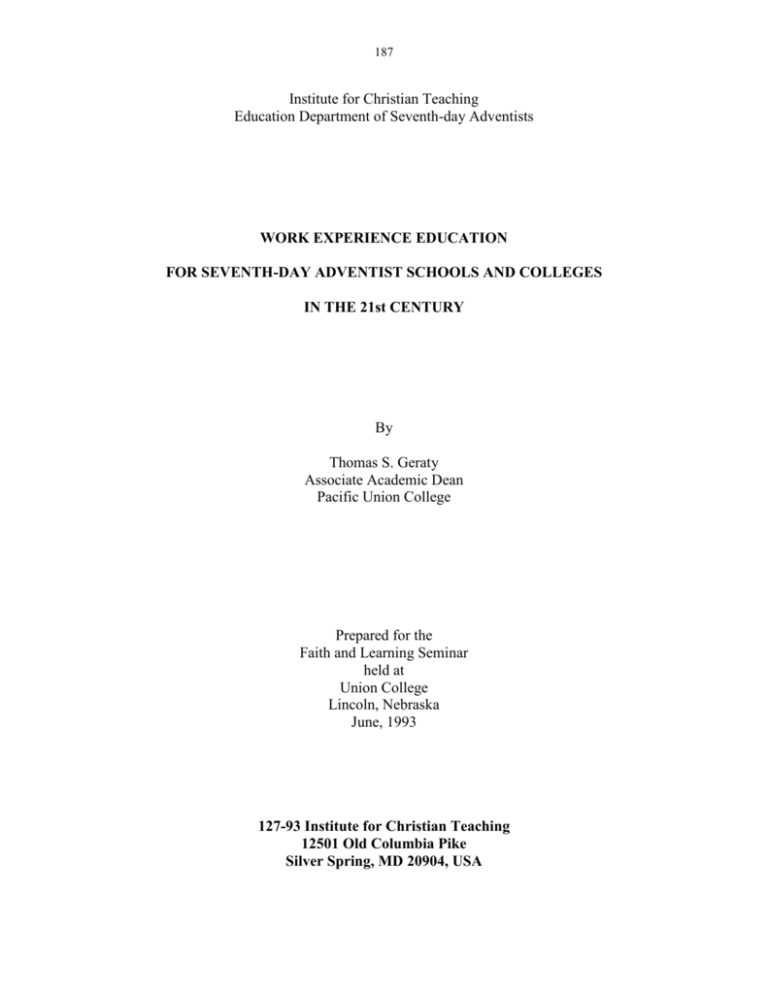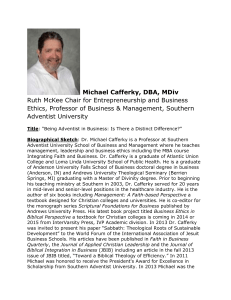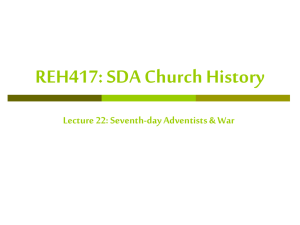for seventh-day adventist schools and colleges
advertisement

187 Institute for Christian Teaching Education Department of Seventh-day Adventists WORK EXPERIENCE EDUCATION FOR SEVENTH-DAY ADVENTIST SCHOOLS AND COLLEGES IN THE 21st CENTURY By Thomas S. Geraty Associate Academic Dean Pacific Union College Prepared for the Faith and Learning Seminar held at Union College Lincoln, Nebraska June, 1993 127-93 Institute for Christian Teaching 12501 Old Columbia Pike Silver Spring, MD 20904, USA 188 In commenting about the days ahead, Edward Cornish, president of the World Future Society, quoted the first principle of "A Pledge to Future Generations" by Allen Tough: "To care about the well-being of future generations [is to realize that] their needs are just as important as those of today."1 Though some might feel fearful to pull aside the curtains of the future, yet divinelyinspired philosophical presuppositions provide a firm foundation upon which to build. With intrepid strokes we frame our paper with (I) Philosophical Background, (II) Historical Tracement, (III) Contemporary Exhibits, (IV) Noncultural Features for Global Application, (V) Obstacles and Solutions for the 21st Century, and (VI) Recommendations for the 21st Century. I. PHILOSOPHICAL BACKGROUND Going back to the origin of humankind, the Bible records that God said, Let us make man in Our image, after our likeness; and let them [male and female] have dominion over the fish of the sea, and over the fowl of the air, and over the cattle, and over all the earth, and over every creeping thing that creepeth upon the earth. So God created man in His own image, in the image of God Created He him: male and female created He them. 2 The Creator gave the human family dominion, responsibility, and work. And the Lord God took the man, and put him into the Garden of Eden to dress it and to keep it . . . [and later] to till the ground from whence he was taken. 3 Commenting upon the Eden school and its activities, a religious author stated: To the dwellers in Eden was committed the care of the garden, 'to dress it and to keep it.' Their occupation was not wearisome, but pleasant and invigorating. God appointed labor as a blessing to humans, to occupy their minds, to strengthen their bodies, and to develop their faculties. In mental and physical activity, Adam and Eve found one of the highest pleasures of their holy existence. And when, as a result of their disobedience, they were driven from their beautiful home, and forced to struggle with a stubborn soil to gain their daily bread, that very labor, although widely different from their pleasant occupation in the Garden, was a safeguard against temptation, and a source of happiness. Those who regard work as a curse, attended though it be with weariness and pain, are cherishing 189 error. The rich often look down with contempt upon the working class; but this is wholly at variance with God's purpose in creating humanity. What are the possessions of even the most wealthy, in comparison with the heritage given to the lordly Adam and Eve? Yet they were not idle. Our Creator, who understands what is for a person's happiness, appointed Adam and Eve their work. The true joy of life is found only by working men and women. The Creator has prepared no place for the stagnating practice of indolence.4 The expressions of work, job, vocation, and lifework elicit within people various connotations. Some definitions might be useful for our mutual understanding. When we speak of lifework or vocation, most people think of the job by which they earn their living. But there is much more to a vocation than that. The work 'vocation' contains a thought that should help shape our thinking about what we do with our whole life. Literally, it means what we are called by God to do in life. It includes not only the way we earn our living, but everything we do. The Oxford English Dictionary explains it this way: 'Vocation'--vocatio, noun of action formed on vocare, to call, summon. 1. The action on the part of God of calling a person to exercise some special function, especially of a spiritual nature, or to fill a certain position; divine influence or guidance toward a definite career; the fact of being called or directed towards a special work in life; natural tendency to, fitness for such work. 2. The particular function or station to which a person is called by God; a mode of life or sphere of action regarded as so determined. 5 As students develop and mature from early childhood on, they think of their lives and what they want to become, what they want to be. Do they wish to replicate the livelihood of their parents, or do they wish to pursue some other means? The school years help to provide a period of exploration and reflection. They offer experiences to orient them into the world of work. Happy are those youth who have the opportunity for enriched environments offered in their formal education or schooling. Programs and curricula may differ, but basically the administrators and teachers in every SDA educational institution should consider providing an environment for the holistic development of the students--physical, emotional, intellectual, spiritual, social, and vocational. 190 Since the inception of SDA education largely as a result of the 1872 vision of Ellen G. White on "Proper Education," 6 the work ethic has been an integral part of the planned curriculum: Daily, systematic labor should constitute a part of the education of the youth. Much can be gained by connecting labor with the schools. In following this plan, students can leave school with strength and courage to persevere in any position in which the providence of God may place them. 7 Curriculum planners, regardless of the grade level, are admonished to keep in mind that A portion of the time each day should be devoted to labor, that the physical and mental powers might be equally exercised. 8 The exercise of the brain in study, without corresponding physical exercise, has a tendency to attract the blood to the brain, and the circulation of the blood through the system becomes unbalanced. The brain has too much blood and the extremities too little. There should be rules regarding their studies to certain hours, and them a portion of their time should be spent in physical labor. 9 Physical labor will not prevent the cultivation of the intellect. Far from it. The advantages gained by physical labor will balance a person and prevent the mind from being overworked. The toil will come upon the muscles and [will] relieve the wearied brain. 10 The divinely-inspired counsel in more specific terms spells out that Some hours each day should be devoted to useful education in lines of work that will help the students in learning the duties of practical life, which are essential for all our youth. 11 In fact, what is recommended for the balanced welfare for the students is likewise recommended to the Christian educators--and even clergy nearby--for consideration: Our teachers should not think that their work ends with giving instruction from books. Several hours each day should be devoted to working with the students in some line of manual training. In no case should this be neglected. 12 Let the teachers in our schools take their students with them into the gardens and fields and teach them how to work the soil in the very best manner. It would be well if ministers who labor in word or doctrine could enter the fields and spend some portion of the day in physical exercise with the students. 13 191 Different teachers should be appointed to oversee a number of students in their work, and should work with them. Thus the teachers themselves will learn to carry responsibilities as burden bearers. 14 In addition to the physical well being of educators, clergy, and students, the out-ofclassroom fellowship enjoyed, the rapport developed, the free association experienced cannot be gainsaid. Time constraints, weekly and daily schedules, and the application of principles in the technological and post-industrial age can be arranged with prioritization. Outdoor activities will be preferable to the indoor labor, if at all possible. What is most important is the togetherness of children and youth with adults. God gave talents to workers in Israel, such as to Bezaleel and Aholiab (Ex. 31:1-6). What an industrial school was that in the wilderness, having for its instructors Christ and His angels . . . Thus in labor and in giving they were taught to cooperate with God and with one another. And they were to cooperate also in the preparation of the spiritual building--God's temple in the soul. 15 The Master Workman of the universe has assured us of His plans and purposes: The experiences of Israel were recorded for our instruction . . .With us as with Israel of old, success in education depends on fidelity in carrying out the Creator's plans. 16 The great principles of education are unchanged. They stand fast for ever and ever. (Ps. 111:8); for they are the principles of the character of God. 17 Depending upon the country in the world, the geographical location, and the economic milieu, work experience education (WEE) may represent a cooperative effort of the school and community to provide opportunities for students to work, to develop attitudes and skills, and to discover their career interests. 18 Administrators, faculty, staff, and Boards of Control in Seventh-day Adventist schools and colleges are in a position to take the platitudes and dreams to reality and to move the purposes of God from goals to realization. 192 With God's explicit framework, mandate, and responsibility for success, for what are we waiting? II. HISTORICAL TRACEMENT Besides the references previously made to the Garden of Eden and to the Hebrew economy, which could have included the schools of the prophets (II Kings 6:1-7), Christ as the carpenter gave us the ultimate Exemplar: He was not willing to be defective, even in the handling of tools. He was as perfect a workman as He was perfect in character. Every article He made was well made, the different parts fitting exactly, the whole able to bear the test. 19 Writing of the nineteenth century, Everett Dick made reference to the fact that The early Adventists were dyed-in-the-wool reformers and were tremendously influenced by Oberlin College, a reform institution founded in 1833, which included emphasis upon the student's working with his hands as he developed his mind. An attempt had been made at Battle Creek College to follow the Oberlin plan, but the program had made slow progress in competition with the conventional type of class education. 20 The president of the General Conference of Seventh-day Adventists, Elder George I. Butler, who was chairman of the College Board, wrote regarding the temporary closing of Battle Creek College in 1882-1883 that The spirit of pride and display and vanity and worldly success has been far too prominent. We firmly believe if this institution had never been called a College, but had simply been a school of instruction, where our young people could come to learn things that would make them useful . . . that it would have accomplished far more good that it has. 21 It is possible for a school to lose sight of its purpose, its mission, with its curriculum and activities. Let teachers . . . not advise students to give years of study to books . . . Let the student set himself to work at manual labor . . . These years of study are cultivating many habits and methods in the students that will cripple their usefulness . . . The constant working of the brain causes a diseased imagination. It leads to dissipation. (To G. A. Irwin, 7/22. I-761897). 22 193 In the establishment of Battle Creek College, Healdsburg College (Pacific Union College), and South Lancaster Academy (Atlantic Union College), an earthly principle was recognized by contemporary educators: Some new features will doubtless be introduced in them [SDA schools], which have never been connected with our college. God has given us light in reference to the principles upon which such schools should be conducted. The best educators of our land are dissatisfied with the present methods of education. They are too superficial, and fail to qualify the student for the most important duties in life. Many who come forth with a University education are helpless as babes in the everyday business of life, and are easily outstripped by country school boys who know little of books, but much of the practical work of life. Book education should be connected with manual labor. These educators see the importance of this, and are urging it. Such schools are being established here and there. 23 In planning for the Seventh-day Adventist school in New England It is also hoped that Miss Edith Sprague, a graduate of Battle Creek College under the high standard of discipline and thoroughness maintained in it by Professors Brownsberger and Bell, will assist in the management of this school [at South Lancaster, Massachusetts]. These facts will be of sufficient guarantee to our brethren of a successful commencement. Arrangements have already been partially made with persons to take charge of gardening, and the culinary and other departments of manual labor to be connected with the school. 24 Writing of how well the school year was prospering, Elder S. N. Haskell stated that a wood yard had been opened at the school and that The students labor three hours per day, and by this means they have in some instances been enabled to nearly pay their board . . . The housework is performed by the lady students. We have felt the lack of a competent person to take charge of this department of the work; but by a general agreement the students have for some time shared the responsibility among themselves. It is rather amusing at times to hear the conversation between a fresh arrival, and those who have been here longer. Fresh arrival says, 'I could get plenty of work at home--did not come here to work this way.' 'Didn't you expect to work if you came here?' Says the other, 'I did and did not expect to get anything for it either.' 25 194 In implementing the work-study concept, the school authorities decided " . . . to make arrangements so that all the students will be employed in useful labor during certain hours of each day." 26 Even in the 1883 minutes of the Battle Creek College Board was stuck a page of notes which included "that the students' time should be divided between study and work, so as to furnish physical as well as mental development." The president of the General Conference, Elder G. I. Butler, extracted some results of a British Association quoted in the New York Tribune showing the practical importance of combining physical and mental labor in the education of the young. 27 Happily the West Coast College provided The complete equipments for learning the principal kinds of manual labor. The primary object . . . is to afford students an opportunity to alternate physical with mental activity, thereby securing a healthful condition of mind and body. But there is another end equally important; that is, the inculcation of correct views of life and the formation of habits of industry and usefulness. Secondarily, it is desirable that students should become producers, as well as consumers, during the period of their school life. 28 Industrial education and the combining of "physical labor with mental discipline" became prominent in both public and Seventh-day Adventist schools. 29 The emphasis on hands, heads, and hearts--manual and intellectual--was given much prominence in early Adventist education. 30 In Australia at Avondale College, which was dubbed "a model school" for the church, The daily program of the school is something as follows: The rising-bell is at 5:45 a.m.; prayers, 6:15; breakfast at 7; school opens at 8:45; regular classwork begins at 9:15, continuing until 1:15 p.m.; and dinner is at 1:30. Then comes three hours of labor. 31 In both North America and in Australia the objectives of student employment in manual labor were explicit: The purpose of these departments is threefold--to educate the youth in practical labor, to give means of support, and to provide physical exercise. 32 195 Educators E. A. Sutherland outlined cogently the purpose of education for Sparta, Athens, Rome, and what is needed for the Christian soldier of Jesus Christ. 33 Elders S. N. Haskell and A. T. Jones preached on the subjects of Christian education. 34 Percy T. Magan called for "A New Order of Things," and David Paulson introduced a "House in the Country and a School in the Woods." 35 One of the reputable college history teachers, H. A. Washburn, pled for the "Self-Support of Students" in agricultural education and in mechanical pursuit. 36 Ms. M. Bessie DeGraw featured the daily program of the Nashville (TN) Agricultural and Normal Institute, forerunner of Madison College: In the meantime we study and work. The forenoon is devoted to manual work. The men have just finished a four-room cottage, which lady students will occupy; they are building a milk room and a small bath house, and they are repairing the barn for the cows, and building a barn for the mules . . . service closes the day. 37 Although we have traced briefly some of the school developments of the North American Division of Seventh-day Adventists in the nineteenth century, the General Conference Secretary of Education, Warren E. Howell, in a report quoted two paragraphs of guidance for SDA schools and colleges: 38 1. The Lord opened before me the necessity of establishing a school at Battle Creek that should not pattern after any school in existence. 39 2. I have been shown that in our educational work we are not to follow the methods that have been adopted in our older established schools. 40 We need not lock step our polity and policy, but why not use adaptation, creativity, and originality in offering what is best for student needs? Constituencies, geography, climates, and locales differ. There followed, then, in The Adventist Review and Sabbath Herald a series of succinct articles on "A Review of the Pattern for Christian Education" and "Working to the Pattern in Christian Education," which are apropos in principle for any generation regardless of culture or clime. 41 196 III. CONTEMPORARY EXHIBITS Seventh-day Adventist schools and colleges have been endeavoring through the decades until the present to implement, more or less, the outlined seminal principles of work experience education (WEE) and a combining of manual labor with mental studies as found in: CT CT CT CT CT Ed FE FE FE FE FE PP 3T 4T 6T 6T 6T 273 281 285 294 307 214 15 71 95 145 416 592 131 418 177 181 206 The Dignity of Labor Words o Counsel Physical Labor for Students Health and Efficiency A Practical Training Manual Training Proper Education The Importance of Physical Training The School of the Ancient Prophets Education and Health Manual Training The Schools of the Prophets Proper Education (1872) Our College (1881) Industrial Reform The Avondale School Farm School Management and Finance To see how some SDA schools and colleges have been operating their work experience education (WEE), we introduce anonymously some illustrations: ELEMENTARY SCHOOL MODELS School A: The children in the grades/standards do all the custodial work and the older students, school repairs. The teachers are supervisors. School B: Both the teacher and students have prepared the soil and have planted gardens. They have landscaped the grounds and care for the flowers and plants. School C: Gives service credit for work done at home. Building a fire in the morning; milking two cows before and after school; cleaning out the barn in the afternoon; splitting and carrying in the fuel for the wood stove; feeding the chickens; gathering the eggs. School D: Gives service credit for home duties. Delivering daily newspapers; washing and wiping dishes; scrubbing the floor; making beds; preparing evening meals. 197 School E: For homework. Leave for school after washing hands, nails, face, teeth; bathing and dressing baby; goes to bed without complaining. Age 5: Opens gates in morning for calves; gets kindling; takes care of baby; closes chicken door; carries wood for fireplace; dries dishes; leads horses to the plow. Age 6: Hunts eggs; waters the horse and cow; minds baby; hunts firewood from the fields. SECONDARY SCHOOL MODELS School A: Has eight major school industries, plus many campus jobs. There are financial benefits for defraying school expenses. Work times are in hour blocks. All students must work a minimum of 1.5 hours per day. School B: A staggered work-study program for five days using morning and afternoon. Work assignments are graded, and work credit is shown on the student's transcript. School C: The academy builds one house each year, from blueprinting, digging and pouring foundations, framing, plumbing, wiring, plastering, painting, to marketing. 300 clock hours of work per year equals one credit. WEE credit applying toward graduation may not exceed two credits. School D: School has work coordinator who arranges student work sites and schedules, orients, and evaluates the student work. This is domestic labor required of all students for the placement, remuneration, and evaluation of each student. Academic credit is given. Students may decide to have tithe deducted from their wages. School E. Manages a cooperative work program with jobs in the community; a member of the teaching staff works with the employer for the placement, remuneration, and evaluation of each student. Academic credit is given. Students may decide to have tithe deducted from their wages. UNDERGRADUATE SCHOOL MODELS School A: Work on campus in school departments or in off-campus employment is given remuneration with a percentage going to credit the student accounts. Ninety percent of the students work, generally at least 10-12 clock-hours per week. 198 School B: A Work Coordinator for Christian salesmanship or colporteur work is sponsored by the school, orienting students in gospel salesmanship, conducting Bible studies, and house-to-house visitation. School C: Students are employed in departments, offices, fields, and grounds. Students are grouped with a faculty supervisor who works with the students. With the exception of petty cash given, the balance accrues on the student accounts. Students are encouraged to pay tithe, which may be deducted from their income, if they wish. School D: A regular Cooperative Education Program between the college and the employer for off-campus employment in the nearby communities provides a well-regulated arrangement for academic and remunerative credit. School E: Students and teachers work together in elective groups one morning or afternoon each week as may be arranged mutually in physical labor to provide community service for need families or senior citizens. GRADUATE SCHOOL MODELS School A: Fourteen students and two teaching assistants are learning about design and construction, as they build a 300-square-foot house that will eventually be sold at an auction. It is being built on campus, but after the sale it will be moved to a nearby location as a guest or vacation cottage. School B: The School of Education offers two identical Work Experience Education (WEE) summer courses for instruction and demonstration, such as June 18-July 6 and July 9-27. Students will be required to undertake 45 clockhours of classroom instruction and a further 45 clock-hours of work practicum. Each summer seminar will generate four quarter-hours of undergraduate or graduate credit. School C: This university participates in a Federal work-study program allowing students to work a maximum of 12 hours per week. 199 School D: Using the surrounding communities as service areas, each School/Department arranges for staff-student volunteer services. This provides a practicum of value in real-life situations, the length of time for which is determined by the educational institution. School E: The university has no organized program of work or labor, considering such as non-academic. IV. NONCULTURAL FEATURES FOR GLOBAL APPLICATION A. Presuppositions: 1. Every person develops a self-image, a self-concept, a self-worth. Some struggle with their self-esteem. 2. A person has a desire to be needed, to be wanted, to belong. 3. A person wants to do something worthwhile, to be a productive individual, and not just a consumer. 4. Each individual has some kind of ability, a giftedness. 5. Each person should develop his/her God-given talent(s). 6. When perceived by human beings, time has value. 7. Each person must manage himself/herself in time. 8. Opportunities for development--more or less--come to all human beings. 9. To the extent she/he wills, a person absorbs culture. 10. Every individual has the power of choice. 11. Each person chooses criteria for the evaluation of right and wrong, good and evil, work and leisure, intrinsic and extrinsic value. 12. Each activity--mental, creative, physical, or manual--has its place in human service. 13. Human vocation is larger in its meaning than a single job. 14. A person's daily work may be a service to self and/or to others. B. Value of each person: 1. Christ paid an infinite price for us, and according to the price paid He desires us to value ourselves. 42 2. The Lord is disappointed when His people place a low estimate upon themselves. He desires His chosen heritage to value themselves according to the price He has placed upon them. 43 C. Values of Work Experience Education: 1. Exercises physical and mental powers. 2. Demonstrates dignity of labor 3. Offers fellowship and social rapport. 4. Enhances a person's self-worth. 200 5. Gives service to others. 6. Assists in personal growth and development. 7. Develops cooperation and teamwork. 8. Provides for living expenses. 9. Helps the balance in daily living. 10. Creates opportunity for mental reflection. V. OBSTACLES & SOLUTIONS FOR THE 21st CENTURY Urban Area Locations: Although some SDA schools and colleges are now located in villages, towns, or cities, the campus repairs, maintenance, and landscaping help provide work opportunities. Cooperative education of school with community firms, businesses, and industries provide work sites and academic credit. Students can offer community service in local job markets, shops, health-related institutions, retirement centers, and in senior citizen homes. Technological Environment Supplants Agricultural: Macro agriculture has given way to mechanization, automation, and high-tech industries, and large tracts of land have been reduced for various kinds of development. Micro agriculture is still a possibility with imaginative experiments and work on campus and in classrooms. Some high-tech industries may offer job sites that will furnish opportunities for physical exercise and manual dexterity. Reduction of Campus Industries: Because of economic restrictions, growing competition in the marketplace, and downsizing, there has been a withering of school-owned/school-operated industries. Some resourceful business people in the church and school constituencies have rented facilities from the SDA school/college, and have started and operated successfully privately-owned industries with student employment. Less Work Stations Than Student Enrollment: Some schools and colleges have restricted work sites, or an insufficient number of work opportunities for the larger number of enrolled students. In such cases, off-campus work opportunities should be explored, and for on-campus work, criteria may be established based on student financial need, limitations on student work loads, and in some instances rotation of student workers. Realities Anticipated for the 21st Century: Greater industrialization, stricter government work codes, urbanization, and the economy will challenge SDA schools and college administration and management to provide viable work stations and Work Experience Education for work-study opportunities. Depending upon their philosophy and mission, if SDA schools and colleges required domestic labor and community service for graduation, these can be arranged with imaginative strategic planning for all their students enrolled. Transcripts of academic scholarship may record clock-hour performance of domestic labor and/or community service. Thus, the objectives of uniting physical labor with mental discipline can be achieved for the daily balanced living of students. 201 VI. RECOMMENDATIONS FOR THE 21st CENTURY In the light of the seminal counsel given to the Seventh-day Adventist Church in "the 1872 Charter" for all SDA schools and colleges--"Proper Education"--church institutional Boards of control, administrators, faculty, and staff should consider that it is within reason to provide for the holistic education of all children, youth, and older students who enroll in Seventh-day Adventist schools and colleges. Though drastic changes and quantum leaps in society, culture, industry, and economics have changed the horizons of educators from the 18th, 19th, and 20th centuries, yet the plan of God for the 21st century makes provision for "Proper Education" in work-study education, such as consideration of the following: A. Elementary/Primary Schools--Should recognize that daily work may be arranged either at school or at home. It is the dual responsibility of the church and parents to provide basic education for each child in the church. B. Secondary Schools--Should make adequate provisions (1) to establish goals and objectives for manual labor on a daily basis; (2) to commit resources; (3) to offer staff development; (4) to arrange school-operated or contracted services in labor; and (5) to budget time and finance for WEE. C. Undergraduate Schools--Should arrange for labor on campus and/or cooperative education, including opportunities for voluntary community service, even if not required in the school curriculum. D. Graduate Schools--Should offer periodically in teacher education and school administration seminars in the philosophy, planning, administration, management, and operation of viable work-study, Work Experience Education Programs. 202 1 2 3 4 5 6 7 8 9 10 11 12 13 14 15 16 17 18 19 20 21 22 23 24 25 26 27 28 29 30 31 32 33 34 35 36 ENDNOTES The Futurist, May-June, 1993, p.15. Genesis 1:26-31 Genesis 2:15; 3:23; 4:12 Ellen G. White, Patriarchs and Prophets, p. 50 WEE, Related Instruction Supplement, Loma Linda Academy, n.d., pp. 3,4. 3T 131-160; FE 15-46; CE 1-30 FE 44; see CT 292 for "even at this late period . . . ." FE 38; 6T 180 3T 138 3T 152 CT 283 CT 211 FE 325 6T 179 Ed 37 Ed 50 Ed 30 General Conference Department of Education, Guide for Work Experience Education in SDA Schools and Colleges. General Conference of SDA, Revised Edition, 1983. 121p. Paperback. Study the purpose, strategies, and overall possible arrangement for "Work Experience Education" (WEE). CG 345 Everett Dick, Union: College of the Golden Cords, Lincoln, Nebraska: Union College, 1967. 131p. Paperback. The Advent Review and Sabbath Herald, July 31, 1883, p. 490 Spalding-Magan Collection, pp. 95, 96 RH, November, Feb. 28, 1882, p. 137 Ibid. RH, November 14, 1882, p. 720. See as well, RH, pp. 233, 265. Also Myron F. Wehtje, And Then There Was Light (1982), p. 282. RH, August 15, 1882, p. 527. ". . . . to write honorable labor with the training of the mind." RH, August 31, 1897, p. 560 RH, December 4, 1883, p. 762 RH, January 15, 1884, p. 37 RH, February 19, 1884, pp. 116, 117; April 22, 1884, p. 260. RH, January 17, 1888, p. 41; November 24,1896, p. 746; December 1, 1896, p. 762; December 12, 1896, p. 826; April 13, 1897, p. 233. RH, August 17, 1897, p. 521 RH, March 22, 1898, pp. 190, 191 RH, April 26, 1898, pp. 271, 272; May 5, 1898, p. 287; "The Gospel in Manual Training," RH, May 17, 1898, pp. 317, 318; December 27, 1898, p. 838. RH, August 15, 1899, pp. 525, 526; October 17, 1899, p. 663; November 7, 1899, pp. 715, 716. RH, March 17, 1903, p. 20; June 2, 1903, pp. 18, 19 RH, March 24, 1904 203 37 38 39 40 41 42 43 RH, January 25, 1906 RH, February 18, 1926 FE 221 CT 533 RH, March 4, 1926, pp. 4, 5; March 11, 1926, pp. 5, 6; March 18, 1926, pp. 6-9; February 9, 1928, pp. 20-23 MH 498 DA 668









